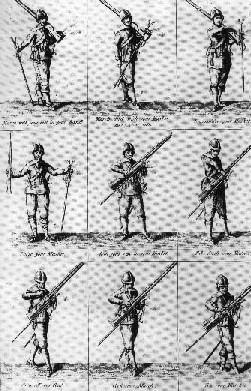
Manual of arms from the 17th century. Handling of the musket required training and drills.
The firearm was still wider used, and eventually replaced pike, crossbow and longbow. It became really effective with the emergence of the well-drilled ranks of soldiers, where the front rank fired their weapon and then stepped back to reload, as the next rank fired their weapons, etc. Although the firearms had an effective range of only 100 yards, this technique created a deadly field of fire in front of the formation.

The only thing capable of threaten this effective infantry formation, was artillery, with its longer range. Because of this, the role of cavalry changed, as its primary objective became the destruction of enemy artillery.
This way of fighting, with a large number of well-drilled infantry, artillery to attack the infantry, and fast cavalry to take out the artillery, did not change much until the 19th century, when new inventions, such as the machine gun, dramatically altered the way of warfare.
The Army Growth of the 16th and 17th Century
With the emergence of the national standing army in the 16th and 17th Century, the size of the armies increased dramatically. The figures below illustrates this:
| date | Spain | Dutch Rep. | France | England | Sweden | Russia |
|---|---|---|---|---|---|---|
| 1470s | 20,000 | - | 40,000 | 25,000 | - | - |
| 1550s | 150,000 | - | 50,000 | 20,000 | - | - |
| 1590s | 200,000 | 20,000 | 80,000 | 30,000 | 15,000 | - |
| 1630s | 300,000 | 50,000 | 150,000 | - | 45,000 | 35,000 |
| 1650s | 100,000 | - | 100,000 | 70,000 | 70,000 | - |
| 1670s | 70,000 | 110,000 | 120,000 | - | 63,000 | 130,000 |
| 1700s | 50,000 | 100,000 | 400,000 | 87,000 | 100,000 | 170,000 |